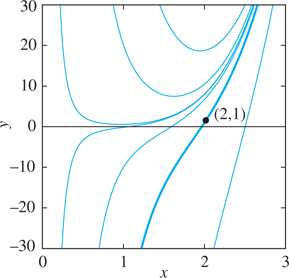 Section 1.1
by C. Henry Edwards,
David E. Penney,
David T. Calvis,
Differential Equations and Linear Algebra, 4th Edition
Section 1.1
by C. Henry Edwards,
David E. Penney,
David T. Calvis,
Differential Equations and Linear Algebra, 4th Edition
- Differential Equations & Linear Algebra
- Contents
- Application Modules
- Preface
- 1 First-Order Differential Equations
- 2 Mathematical Models and Numerical Methods
- 2.1 Population Models
- 2.2 Equilibrium Solutions and Stability
- 2.3 Acceleration–Velocity Models Acceleration–Velocity Models
- 2.4 Numerical Approximation: Euler’s Method Numerical Approximation: Euler’s Method
- 2.5 A Closer Look at the Euler Method
- An Improvement in Euler’s Method
- 2.6 The Runge–Kutta Method The Runge–Kutta Method
- 3 Linear Systems and Matrices
- 4 Vector Spaces
- 5 Higher-Order Linear Differential Equations
- 5.1 Introduction: Second-Order Linear Equations
- 5.2 General Solutions of Linear Equations
- 5.3 Homogeneous Equations with Constant Coefficients
- 5.4 Mechanical Vibrations
- 5.5 Nonhomogeneous Equations and Undetermined Coefficients
- 5.6 Forced Oscillations and Resonance
- 6 Eigenvalues and Eigenvectors
- 7 Linear Systems of Differential Equations
- 7.1 First-Order Systems and Applications
- 7.2 Matrices and Linear Systems
- 7.3 The Eigenvalue Method for Linear Systems
- 7.4 A Gallery of Solution Curves of Linear Systems
- Systems of Dimension n=2
- Real Eigenvalues
- Saddle Points
- Nodes: Sinks and Sources
- Zero Eigenvalues and Straight-Line Solutions
- Repeated Eigenvalues; Proper and Improper Nodes
- The Special Case of a Repeated Zero Eigenvalue
- Complex Conjugate Eigenvalues and Eigenvectors
- Pure Imaginary Eigenvalues: Centers and Elliptical Orbits
- Complex Eigenvalues: Spiral Sinks and Sources
- A 3-Dimensional Example
- 7.4 Problems
- 7.4 Application Dynamic Phase Plane Graphics
- 7.5 Second-Order Systems and Mechanical Applications*
- 7.6 Multiple Eigenvalue Solutions
- 7.7 Numerical Methods for Systems
- 7.7 Application Comets and Spacecraft
- 8 Matrix Exponential Methods
- 9 Nonlinear Systems and Phenomena
- 9.1 Stability and the Phase Plane
- 9.2 Linear and Almost Linear Systems
- 9.3 Ecological Models: Predators and Competitors
- 9.4 Nonlinear Mechanical Systems
- 10 Laplace Transform Methods
- 11 Power Series Methods
- References for Further Study
- APPENDIX A Existence and Uniqueness of Solutions
- APPENDIX B Theory of Determinants
- Answers to Selected Problems
- Index
Section 1.1
11. If
y=y1=x−2 , theny'(x)=−2x−3 andy''(x)=6x−4 , sox2y''+5xy'+4y=x2(6x−4)+5x(−2x−3)+4(x−2)=6x−2−10x−2+4x−2=0 . Ify=y2=x−2ln x , theny'(x)=x−3−2x−3ln x andy''(x)=−5x−4+6x−4ln x , sox2y''+5xy'+4y=x2(−5x−4+6x−4ln x)+5x(x−3−2x−3ln x)+4(x−2ln x)=0 .13.
r=23 14.
r=±12 15.
r=−2 , 116.
r=16(−3±57−−√) 17.
C=2 
18.
C=3 
19.
C=6 
20.
C=11 
21.
C=7 
22.
C=1 
23.
C=−56 
24.
C=17 
25.
C=π/4 
26.
C=−π 
27.
y'=x+y 28.
y'=2y/x 29.
y'=x/(1−y) 31.
y'=(y−x)/(y+x) 32.
dP/dt=kP−−√ 33.
dv/dt=kv2 35.
dN/dt=k(P−N) 37.
y≡1 ory=x 39.
y=x2 41.
y=12ex 42.
y=cosx ory=sinx 43. (b) The identically zero function
x(0)≡0 44. (a) The graphs (figure below) of typical solutions with
k=12 suggest that (for each) the value x(t) increases without bound as t increases.
(b) The graphs (figure below) of typical solutions with
k=−12 suggest that now the value x(t) approaches 0 as t increases without bound.
45.
P(t)=100/(50−t) ;P=100 whent=49 , andP=1000 whent=49.9 . Thus it appears that P(t) grows without bound as t approaches 50.46.
v(t)=50/(5+2t) ;v=1 whent=22.5 , andv=110 whent=247.5 . Thus it appears that v(t) approaches 0 as t increases without bound.47. (a)
C=10.1 ; (b) No such C, but the constant functiony(x)≡0 satisfies the conditionsy'=y2 andy(0)=0 .
-
No Comment